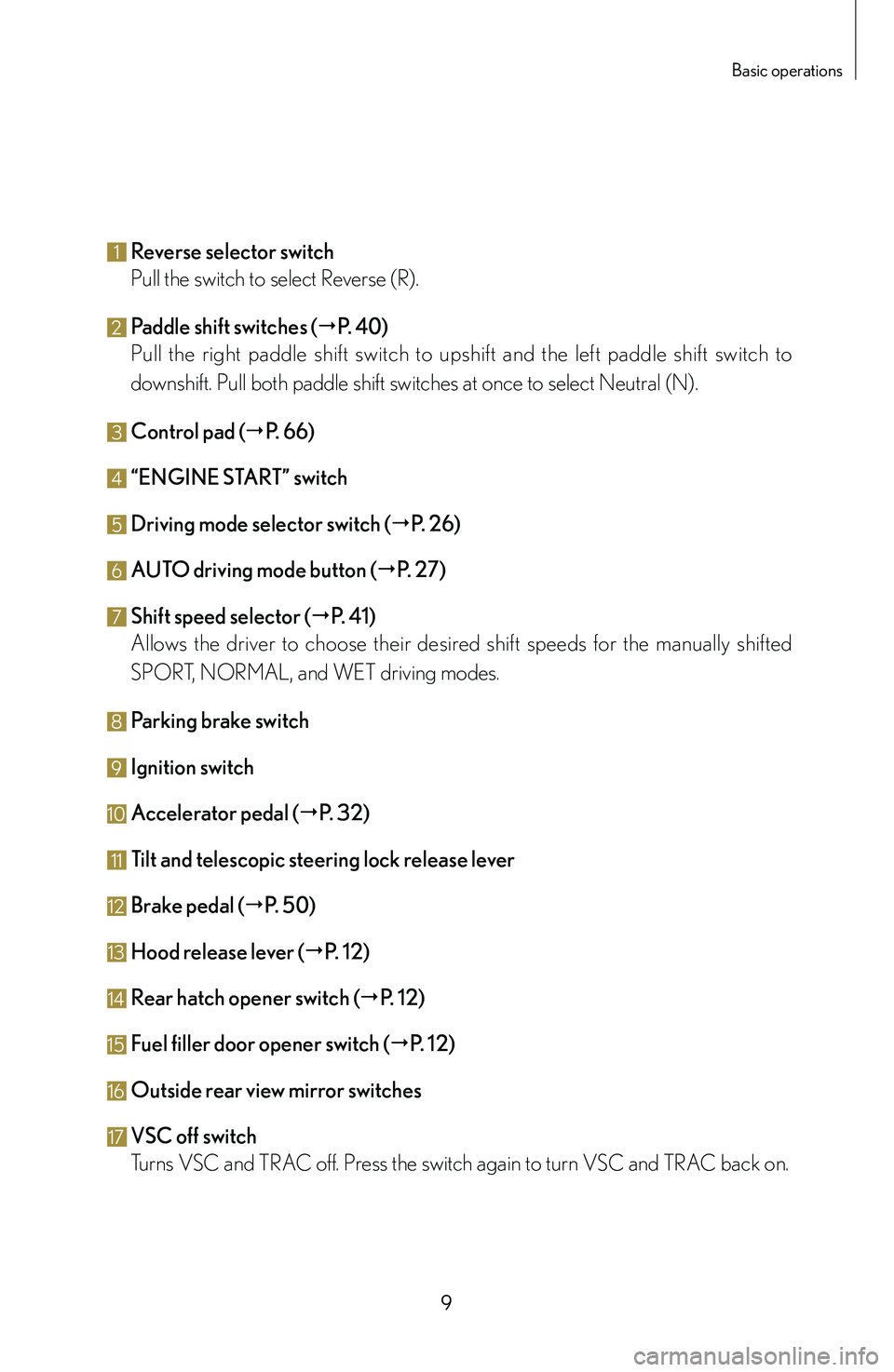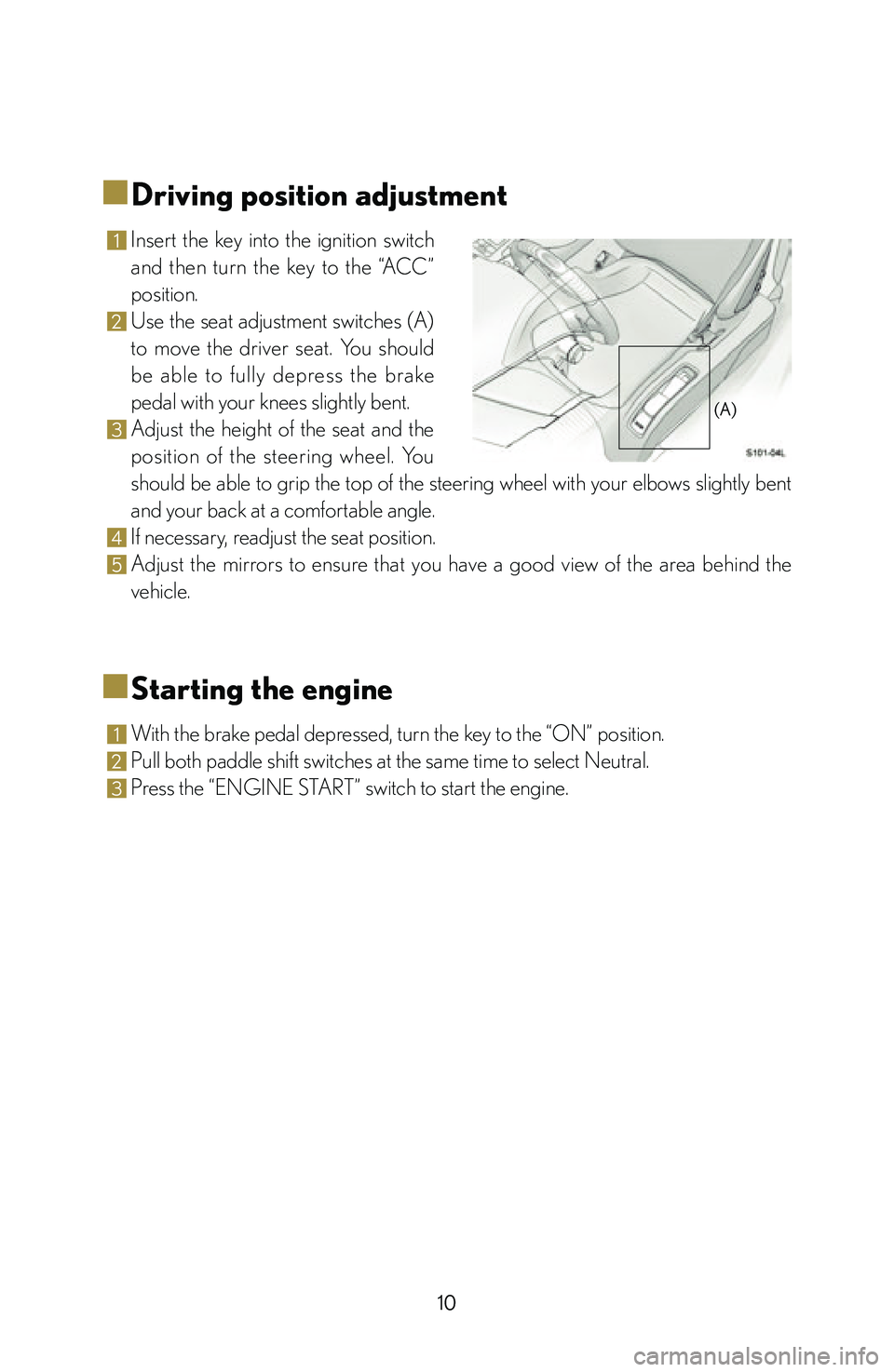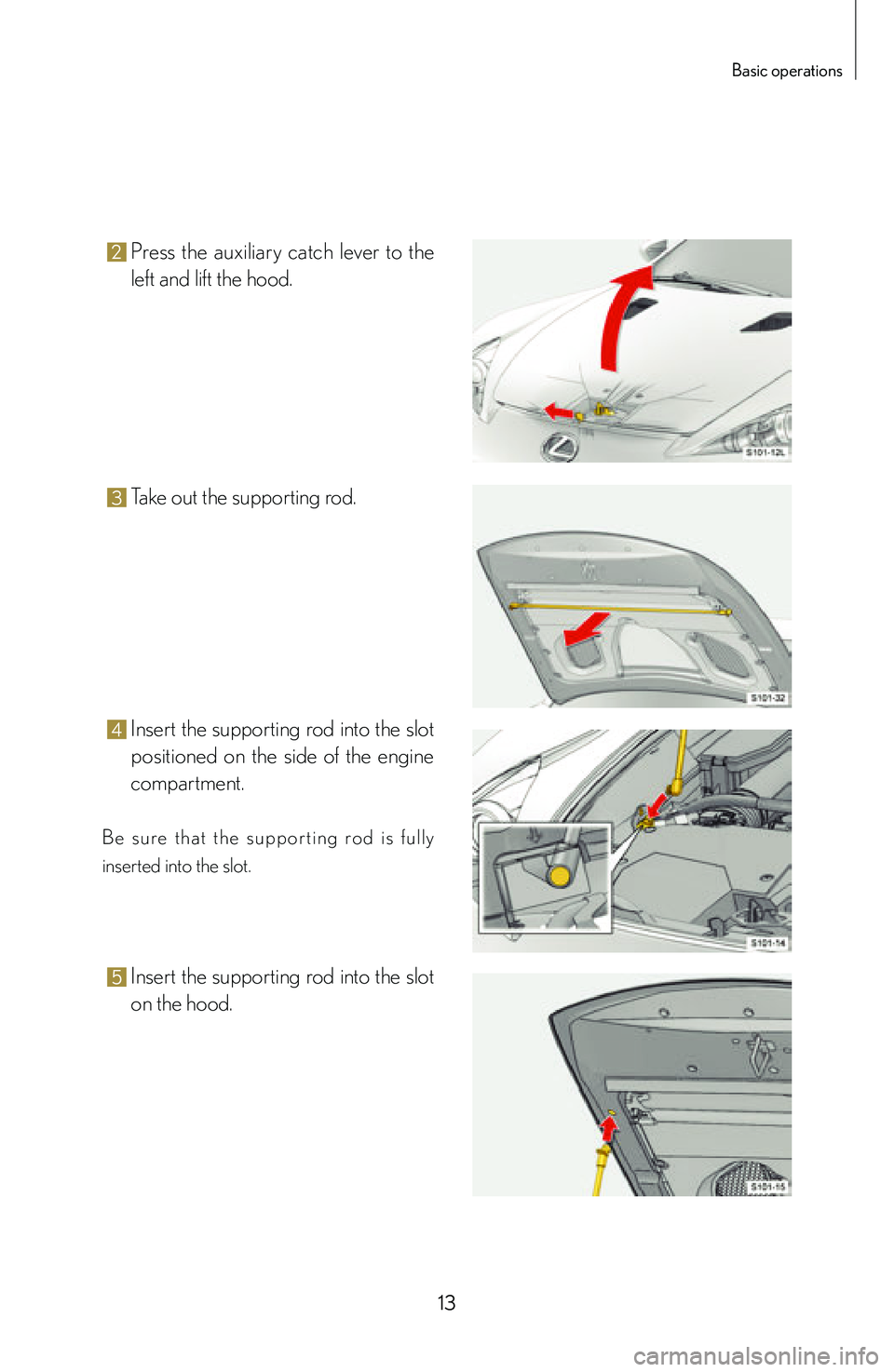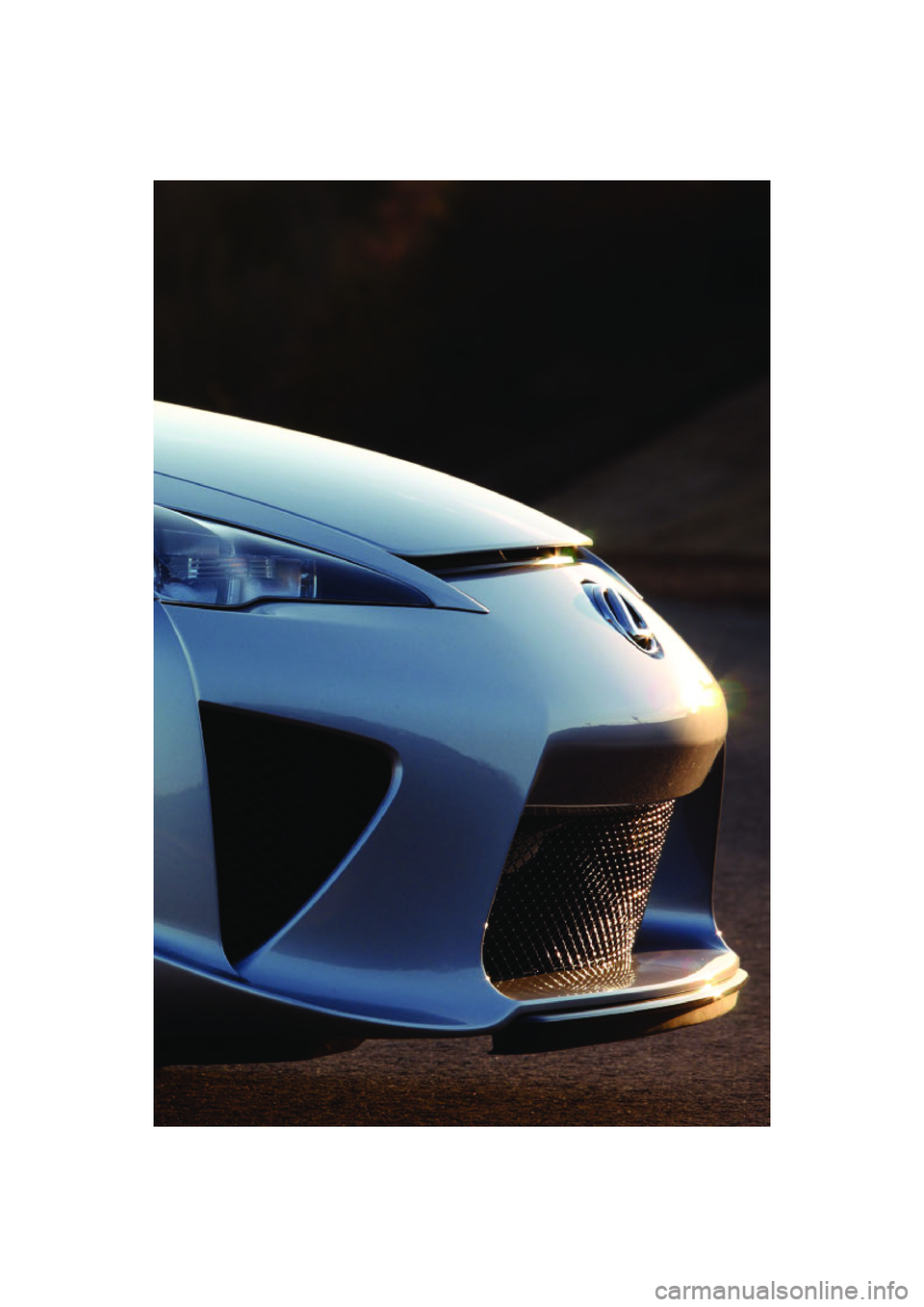lexus LFA 2012 Technical Information / LEXUS 2012 LFA: INSIDE THE LFA
Manufacturer: LEXUS, Model Year: 2012,
Model line: LFA,
Model: Lexus LFA 2012
Pages: 128, PDF Size: 5.91 MB
lexus LFA 2012 Technical Information / LEXUS 2012 LFA: INSIDE THE LFA
LFA 2012
Lexus
Lexus
https://www.carmanualsonline.info/img/36/30118/w960_30118-0.png
lexus LFA 2012 Technical Information / LEXUS 2012 LFA: INSIDE THE LFA
Trending: rate, clock reset, fuel fill door release, towing, AUX, maintenance, oil capacity
Page 11 of 128
9
Basic operations
1 Reverse selector switch
Pull the switch to select Reverse (R).
2 Paddle shift switches ("P. 40)
Pull the right paddle shift switch to upshift and the left paddle shift switch to
downshift. Pull both paddle shift switches at once to select Neutral (N).
3 Control pad ("P. 66)
4 “ENGINE START” switch
5 Driving mode selector switch ("P. 26)
6 AUTO driving mode button ("P. 27)
7 Shift speed selector ("P. 41)
Allows the driver to choose their desired shift speeds for the manually shifted
SPORT, NORMAL, and WET driving modes.
8 Parking brake switch
9 Ignition switch
10 Accelerator pedal ("P. 32)
11 Tilt and telescopic steering lock release lever
12 Brake pedal ("P. 50)
13 Hood release lever ("P. 12)
14 Rear hatch opener switch ("P. 12)
15 Fuel filler door opener switch ("P. 12)
16 Outside rear view mirror switches
17 VSC off switch
Turns VSC and TRAC off. Press the switch again to turn VSC and TRAC back on.
Page 12 of 128
10
■
■Driving position adjustment
1 Insert the key into the ignition switch
and then turn the key to the “ACC”
position.
2 Use the seat adjustment switches (A)
to move the driver seat. You should
be able to fully depress the brake
pedal with your knees slightly bent.
3 Adjust the height of the seat and the
position of the steering wheel. You
should be able to grip the top of the steering wheel with your elbows slightly bent
and your back at a comfortable angle.
4 If necessary, readjust the seat position.
5 Adjust the mirrors to ensure that you have a good view of the area behind the
vehicle.
■
■Starting the engine
1 With the brake pedal depressed, turn the key to the “ON” position.
2 Pull both paddle shift switches at the same time to select Neutral.
3 Press the “ENGINE START” switch to start the engine.
(A)
Page 13 of 128

11
Basic operations
■
■Starting off
1 With the brake pedal depressed, pull the right paddle shift switch to select 1st gear.
2 Pull the parking brake switch to release the parking brake.
3 Release the brake pedal and then slowly depress the accelerator pedal.
■
■Reversing
1 With the vehicle stationary, depress the brake pedal and check the gear indicator
in the meter to ensure that Neutral is selected.
2 Pull the reverse selector switch to select Reverse.
3 Release the brake pedal and then slowly depress the accelerator pedal.
It is not possible to change directly from Reverse to any of the forward gears. Select Neutral first
and then select a forward gear.
■
■Parking
1 Depress the brake pedal until the vehicle comes to a complete stop.
2 Press the parking brake switch to set the parking brake.
3 Ensure that “D1”, “1” or “R” is displayed on the gear indicator.
4 Push in the key and turn it to the “LOCK” position to stop the engine.
The “ENGINE START” switch is for starting the engine. It cannot be used to stop the engine.
Page 14 of 128
12
■
■Opening and closing each door
■
■
Rear hatch
Press the opener switch and then manually lift
up the rear hatch.
If the rear hatch opener switch is inoperable
(
"P. 95)
■
■Fuel filler door
Press the opener switch.
Fuel type Unleaded gasoline only
Fuel tank
capacity
(Reference) 19.3 gal.
(73 L, 16.1 Imp. gal.)
I f t h e f u e l f i l l e r d o o r o p e n e r s w i t c h i s
inoperable (
"P. 95)
■
■Hood
1 Pull the hood release lever.
Page 15 of 128
13
Basic operations
2 Press the auxiliary catch lever to the
left and lift the hood.
3 Take out the supporting rod.
4 Insert the supporting rod into the slot
positioned on the side of the engine
compartment.
B e s u re t h a t t h e s u p p o r t i n g ro d i s f u l l y
inserted into the slot.
5 Insert the supporting rod into the slot
on the hood.
Page 16 of 128
Page 17 of 128
Page 18 of 128
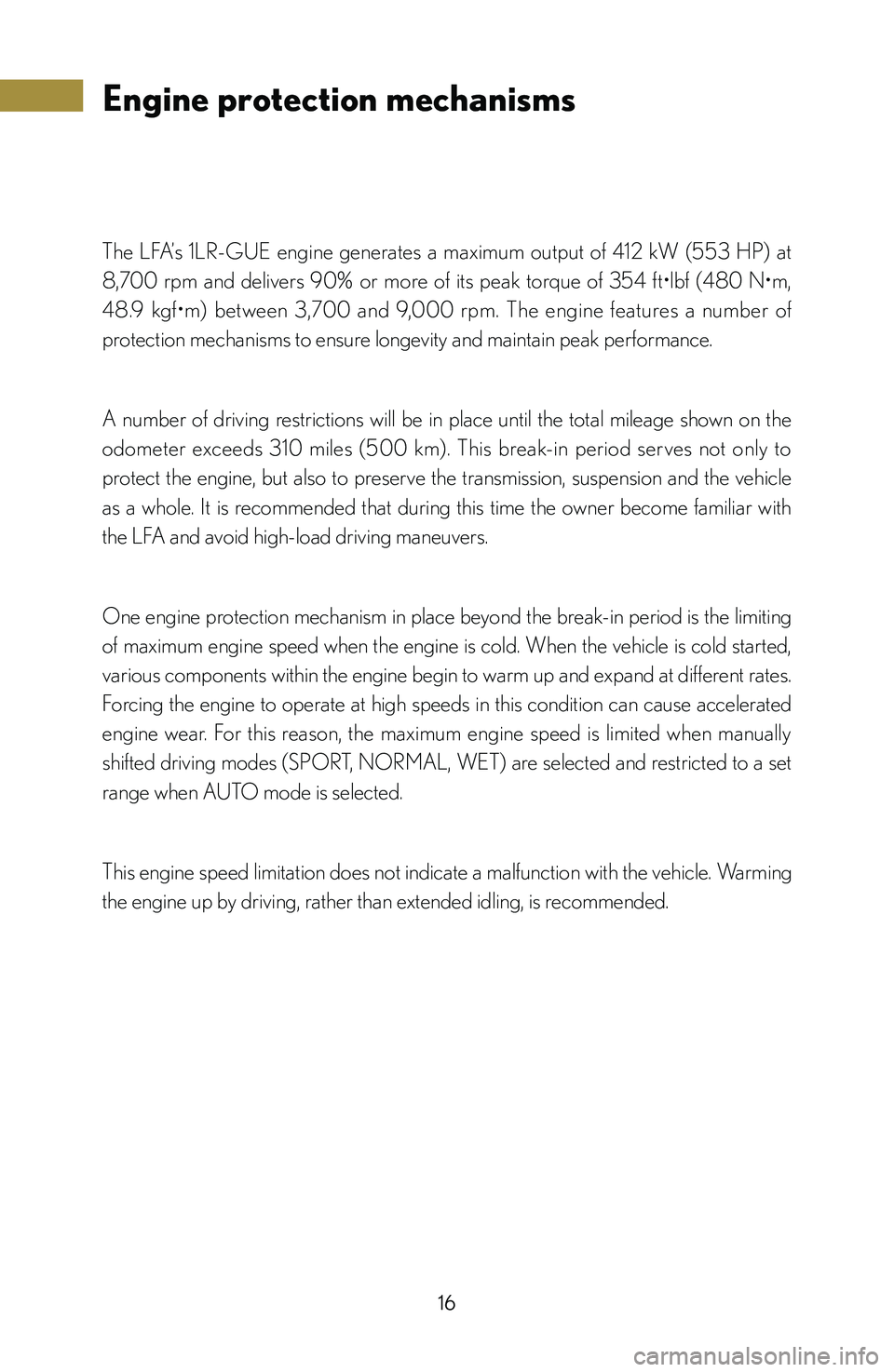
16
Engine protection mechanisms
The LFA’s 1LR-GUE engine generates a maximum output of 412 kW (553 HP) at
8,700 rpm and delivers 90% or more of its peak torque of 354 ft•lbf (480 N•m,
48.9 kgf•m) between 3,700 and 9,000 rpm. The engine features a number of
protection mechanisms to ensure longevity and maintain peak performance.
A number of driving restrictions will be in place until the total mileage shown on the
odometer exceeds 310 miles (500 km). This break-in period serves not only to
protect the engine, but also to preserve the transmission, suspension and the vehicle
as a whole. It is recommended that during this time the owner become familiar with
the LFA and avoid high-load driving maneuvers.
One engine protection mechanism in place beyond the break-in period is the limiting
of maximum engine speed when the engine is cold. When the vehicle is cold started,
various components within the engine begin to warm up and expand at different rates.
Forcing the engine to operate at high speeds in this condition can cause accelerated
engine wear. For this reason, the maximum engine speed is limited when manually
shifted driving modes (SPORT, NORMAL, WET) are selected and restricted to a set
range when AUTO mode is selected.
This engine speed limitation does not indicate a malfunction with the vehicle. Warming
the engine up by driving, rather than extended idling, is recommended.
Page 19 of 128
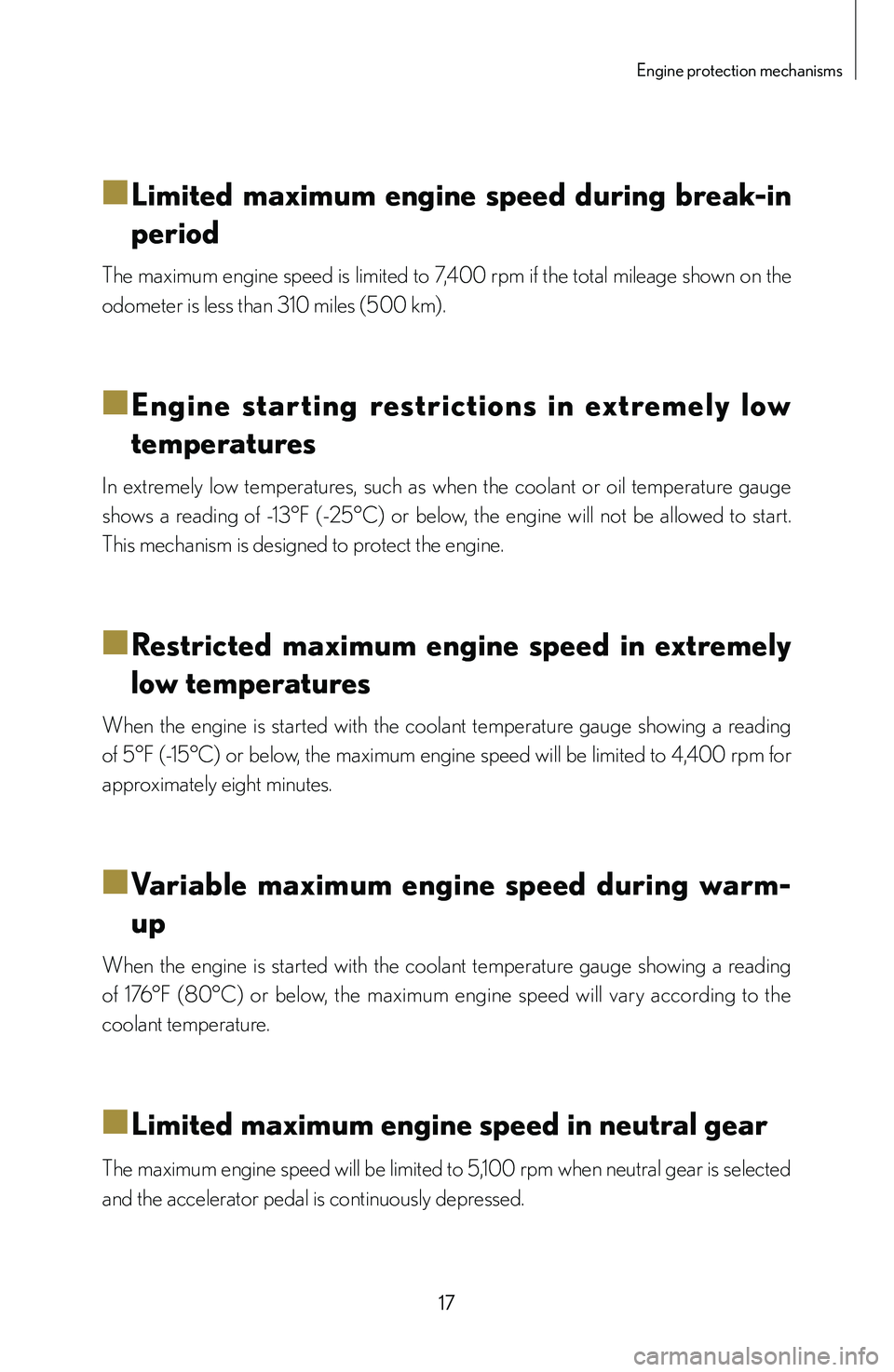
17
Engine protection mechanisms
■
■Limited maximum engine speed during break-in
period
The maximum engine speed is limited to 7,400 rpm if the total mileage shown on the
odometer is less than 310 miles (500 km).
■
■Engine starting restrictions in extremely low
temperatures
In extremely low temperatures, such as when the coolant or oil temperature gauge
shows a reading of -13°F (-25°C) or below, the engine will not be allowed to start.
This mechanism is designed to protect the engine.
■
■Restricted maximum engine speed in extremely
low temperatures
When the engine is started with the coolant temperature gauge showing a reading
of 5°F (-15°C) or below, the maximum engine speed will be limited to 4,400 rpm for
approximately eight minutes.
■
■Variable maximum engine speed during warm-
up
When the engine is started with the coolant temperature gauge showing a reading
of 176°F (80°C) or below, the maximum engine speed will vary according to the
coolant temperature.
■
■Limited maximum engine speed in neutral gear
The maximum engine speed will be limited to 5,100 rpm when neutral gear is selected
and the accelerator pedal is continuously depressed.
Page 20 of 128
Trending: fuse box location, check engine light, suspension, engine overheat, battery location, gas type, radiator
